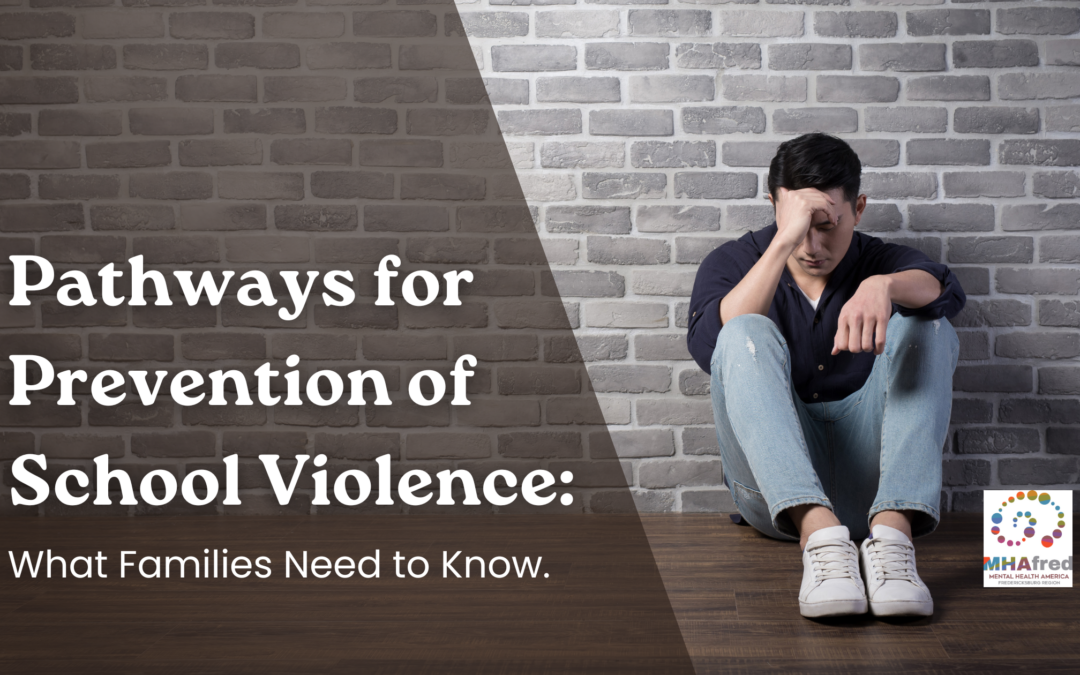Recently, MHAfred staff attended suicide prevention training presented by the Virginia Department of Criminal Justice Services and learned that MHAfred’s programs align with these recommendations.
School violence and youth suicide are critical issues that require a multifaceted approach to prevention and intervention. Developed by Safe and Sound Schools for the Virginia Department of Criminal Justice Services, the “Pathways for Prevention of School Violence” presentation outlines essential strategies and statistics to address these challenges effectively.
Continue reading to find a comprehensive list of resources and information regarding violence and suicide.
Understanding the Magnitude of the Problem
According to the 2019 Youth Risk Behavior Survey (YRBS), a significant percentage of high school students experience suicidal thoughts and behaviors:
- 18.8% seriously considered suicide
- 15.7% made a suicide plan
- 8.9% attempted suicide
- 2.5% required medical attention after a suicide attempt
These statistics highlight the urgent need for comprehensive prevention and intervention strategies.
The Impact of COVID-19
The COVID-19 pandemic has exacerbated mental health issues among adolescents. Research indicates a 26.2% increase in suicide attempts among females aged 12-17 during the summer of 2020 compared to the previous year. Factors such as social distancing, barriers to mental health treatment, and increased stress and anxiety have contributed to this rise. However, increased time at home has also helped some parents recognize their children’s mental health struggles, leading to timely interventions.
Tiered Approach to Suicide Prevention and Intervention
The presentation outlines a tiered approach to suicide prevention and intervention:
Tier 1: Prevention
- Recognizing Risk and Protective Factors: Identifying warning signs and promoting protective factors such as effective healthcare, social connections, and restricted access to lethal means.
- Positive Messaging: Emphasizing hope, help, and recovery through social connections and empowering teachers and families.
Tier 2: Intervention
- School-Based Suicide Intervention: Implementing risk assessment and referral procedures by mental health professionals. This includes direct questioning about suicidal thoughts and assessing the severity of the risk.
- Parent Contact and Documentation: Ensuring parents are informed and involved in the intervention process, with proper documentation of all actions taken.
Tier 3: Postvention
- School Re-Entry: Supporting students’ gradual return to school, monitoring progress, and collaborating with mental health providers.
- Suicide Postvention: Assisting survivors in the grief process, identifying individuals at risk, and continuing prevention efforts to minimize contagion.
Identifying Vulnerable Populations
Certain groups are more vulnerable to suicidal thoughts and behaviors, including:
- Youth with Mental Health and Substance Use Disorders
- LGBTQIA+ Youth
- Youth from Military Families
- Unhoused Youth
- Youth Bereaved by Suicide
Cultural considerations are also crucial, as different communities may have unique risk factors and protective factors. Keep reading to find resources for vulnerable youth populations.
Scenarios and Discussion
The presentation includes scenarios to help educators and mental health professionals identify risk factors, warning signs, and protective factors in real-life situations. For example, Eddy, a 10th-grade student, shows signs of isolation and declining academic performance after his family faced financial struggles. Recognizing these signs and intervening early can make a significant difference in his mental health and well-being.
Getting Involved
If you would like to get involved or find more information about what our community is doing to combat youth suicide, call MHAfred at (540) 371-2704. Our staff works closely with the Suicide Prevention Coalition as the lead for the youth sub-committee on suicide.
Conclusion
Preventing school violence and youth suicide requires a collaborative effort from schools, families, and communities. By understanding the risk factors, implementing tiered prevention and intervention strategies, and addressing the unique needs of vulnerable populations, we can create safer and more supportive environments for our youth.
Below are resources for youth and vulnerable populations:
Resources for Youth with Mental Health & Substance Use Disorders:
- Information from Mental Health America
- Treatment Facility Locator
- Mental Health America Screening Tool for Youth
Resources LGBTQIA+ Youth:
- Resources from Mental Health America
- The Trevor Project: Call 1-866-488-7386 or text START to 678678. A national 24-hour, toll free confidential suicide hotline for LGBTQ youth.
- Trans Lifeline: Dial 877-565-8860 for US and 877-330-6366 for Canada. Trans Lifeline’s Hotline is a peer support service run by trans people, for trans and questioning callers.
Resources from Military Families and Youth:
- Helping Children with Deployment
- Reconnecting with Your Children
- Helping Children Cope with Tragedy Related Anxiety
Resources for Youth Bereaved by Suicide
For more information and resources:
- MHAfred HELPLINE: A comprehensive mental health provider database serving the City of Fredericksburg and the counties of Stafford, Spotsylvania, King George, and Caroline.
- Visit the Virginia Department of Education’s Suicide Prevention Resources Page.
- Youth Information and Support from Mental Health America
- Reducing the Risk of Youth Suicide: a discussion of education, prevention, and early intervention. Webinar with Vibrant, Crisis Text Line, the NPAIHB THRIVE Project, and MHA Fredericksburg Region.
- The Boys Town National Hotline. (800)-448-3000.
- The Jed Foundation. Suicide prevention for college students.
- Covenant House. Resources for homeless and at-risk children.
- 988 Lifeline: Call or text 988 or chat 988lifeline.org. The 988 Suicide & Crisis Lifeline is a national network of local crisis centers that provides free and confidential emotional support to people in suicidal crisis or emotional distress 24 hours a day, 7 days a week.
- Crisis Text Line: Text HOME to 741741 and you’ll be connected to a trained Crisis Counselor. Crisis Text Line provides free, text-based support 24/7.

